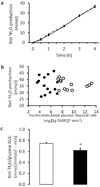Postprandial whole-body glycolysis is similar in insulin-resistant and insulin-sensitive non-diabetic humans
- PMID: 22173627
- PMCID: PMC4360888
- DOI: 10.1007/s00125-011-2413-0
Postprandial whole-body glycolysis is similar in insulin-resistant and insulin-sensitive non-diabetic humans
Abstract
Aims/hypothesis: Insulin resistance is characterised by impaired glucose utilisation when measured by a euglycaemic-hyperinsulinaemic clamp. We hypothesised that, in response to postprandial conditions, non-diabetic individuals would have similar intracellular glycolytic and oxidative glucose metabolism independent of the degree of insulin resistance.
Methods: Fourteen (seven male) sedentary, insulin-sensitive participants (mean ± SD: BMI 25 ± 4 kg/m²; age 39 ± 10 years; glucose disposal rate 9.4 ± 2.1 mg [kg estimated metabolic body size]⁻¹ min⁻¹) and 14 (six male) sedentary, non-diabetic, insulin-resistant volunteers (29 ± 4 kg/m²; 34 ± 13 years; 5.3 ± 1.2 mg [kg estimated metabolic body size]⁻¹ min⁻¹) received after a 10 h fast 60 g glucose plus 15 g [6,6-²H₂]glucose. Serum glucose and insulin concentrations, plasma ²H enrichment and whole-body gas exchange were determined before glucose ingestion and hourly thereafter for 4 h. Plasma ²H₂O production is an index of glycolytic disposal. On day 2, participants received a weight-maintenance diet. On day 3, a euglycaemic-hyperinsulinaemic clamp was performed.
Results: Insulin-resistant individuals had about a twofold higher postprandial insulin response than insulin-sensitive individuals (p = 0.003). Resting metabolic rate was similar in the two groups before (p = 0.29) and after (p = 0.33-0.99 over time) glucose ingestion, whereas a trend for blunted glucose-induced thermogenesis was observed in insulin-resistant vs insulin-sensitive individuals (p = 0.06). However, over the 4 h after the 75 g glucose ingestion, glycolytic glucose disposal was the same in insulin-sensitive and insulin-resistant individuals (36.5 ± 3.7 and 36.2 ± 6.4 mmol, respectively; p = 0.99). Similarly, whole-body carbohydrate oxidation did not differ between the groups either before or after glucose ingestion (p = 0.41).
Conclusions/interpretation: Postprandial hyperinsulinaemia and modest hyperglycaemia overcome insulin resistance by enhancing tissue glucose uptake and intracellular glucose utilisation.
Figures


Similar articles
-
Effect of sustained physiologic hyperinsulinaemia and hyperglycaemia on insulin secretion and insulin sensitivity in man.Diabetologia. 1994 Oct;37(10):1025-35. doi: 10.1007/BF00400466. Diabetologia. 1994. PMID: 7851681 Clinical Trial.
-
Urinary C-peptide excretion: a novel alternate measure of insulin sensitivity in physiological conditions.Obesity (Silver Spring). 2010 Sep;18(9):1852-7. doi: 10.1038/oby.2010.70. Epub 2010 Apr 1. Obesity (Silver Spring). 2010. PMID: 20360760 Free PMC article.
-
Multiple defects of both hepatic and peripheral intracellular glucose processing contribute to the hyperglycaemia of NIDDM.Diabetologia. 1995 Mar;38(3):326-36. doi: 10.1007/BF00400638. Diabetologia. 1995. PMID: 7758880
-
Postprandial microvascular blood flow in skeletal muscle: Similarities and disparities to the hyperinsulinaemic-euglycaemic clamp.Clin Exp Pharmacol Physiol. 2020 Apr;47(4):725-737. doi: 10.1111/1440-1681.13237. Epub 2020 Jan 20. Clin Exp Pharmacol Physiol. 2020. PMID: 31868941 Review.
-
Glucose metabolism in obese subjects: lessons from OGTT, IVGTT and clamp studies.Int J Obes Relat Metab Disord. 1995 Sep;19 Suppl 3:S14-20. Int J Obes Relat Metab Disord. 1995. PMID: 8581072 Review.
Cited by
-
Insights on the Role of Putative Muscle-Derived Factors on Pancreatic Beta Cell Function.Front Physiol. 2019 Aug 8;10:1024. doi: 10.3389/fphys.2019.01024. eCollection 2019. Front Physiol. 2019. PMID: 31440170 Free PMC article. Review.
-
Standard hypothyroid treatment did not restore proper metabolic response to carbohydrate.Endocrine. 2021 Jan;71(1):96-103. doi: 10.1007/s12020-020-02334-0. Epub 2020 May 13. Endocrine. 2021. PMID: 32405763 Free PMC article.
-
Failure of hyperglycemia and hyperinsulinemia to compensate for impaired metabolic response to an oral glucose load.J Diabetes Complications. 2015 Mar;29(2):238-44. doi: 10.1016/j.jdiacomp.2014.11.009. Epub 2014 Nov 24. J Diabetes Complications. 2015. PMID: 25511878 Free PMC article.
References
-
- McGarry JD. What if Minkowski had been ageusic? An alternative angle on diabetes. Science. 1992;258:766–770. - PubMed
-
- DeFronzo RA, Tobin JD, Andres R. Glucose clamp technique: a method for quantifying insulin secretion and resistance. Am J Physiol. 1979;237:E214–E223. - PubMed
-
- Kelley DE, Goodpaster B, Wing RR, Simoneau JA. Skeletal muscle fatty acid metabolism in association with insulin resistance, obesity, and weight loss. Am J Physiol. 1999;277:E1130–E1141. - PubMed
Publication types
MeSH terms
Substances
Grants and funding
LinkOut - more resources
Full Text Sources
Miscellaneous

